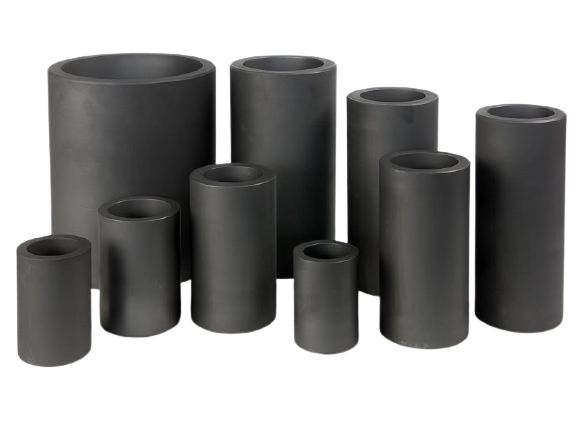AN ISO 9001 : 2008 CERTIFIED CO
AN ISO 9001 : 2008 CERTIFIED CO
What is a Graphite Crucible?
A graphite crucible is a container used for melting and casting non-ferrous, non-iron metals such as gold, silver, aluminum, and brass. The main reason graphite crucibles are popular as a manufacturing tool is their thermal conductivity, high temperature resistance, small thermal expansion coefficient for high temperature applications, and their anti strain properties to rapid heating and cooling. They are corrosion resistant to acids and alkaline solutions and have excellent chemical stability.
Graphite can be produced from natural graphite that is a naturally occurring crystalline form of carbon. This form of graphite is manufactured by combining graphite with fire resistant clay or carbon dioxide.
Synthetic graphite is produced by processing petroleum pitch and petroleum coke, which are byproducts of the oil refining process. It has a purer high fixed carbon content with very few impurities and a low sulphur content.
Ø A graphite crucible is a container used for melting and casting non-ferrous, non-iron, metals such as gold, silver, aluminum, and brass.
Ø The quality of a graphite crucible is determined by how it is manufactured, which influences its structure, density, porosity, and strength.
Ø Graphite crucibles are ideal for melted metal processes because they are non-reactive and able to survive extremely high temperatures.
Ø The type of metal to be processed determines the type of graphite crucible that will be used.
Why Do You Need a Crucible for Melting?
In some applications, such as refining and melting precious metals, base metals and other metal products, crucibles are designed for melting at 1600 degree celsius. In other applications, crucibles that allow the inductive field to pass through them and heat the metal charge directly are used. The benefits of a crucible lie in its ability to withstand very high temperatures which makes it suitable for melting different types of metal for metallurgy. The importance of furnace crucibles cannot be overemphasized in the process of melting and casting metals as it increases the effectiveness and efficiency of melting with an induction furnace.
How Do You Select The Right Crucible For Your Operation
Ø The capacity, dimensions and type of your furnace.
Ø The specific alloy or range of alloys you melt.
Ø The melting and/or holding temperatures you maintain.
Ø The temperature change rate the crucible will experience.
Ø How the crucible is charged.
Ø The fluxes or additions used.
Ø Degassing or refining processes.
Ø How slag or dross is removed.
Ø How the crucible is emptied.
Classification of Crucibles
There are three different graphite processing levels for Superbmelt graphite crucibles, they are; the moulded graphite process, isostatic pressed graphite process and medium coarse graphite process.
1) Moulded Graphite Crucible

Moulded means it is cold pressed by molding. It is a type of graphite that is isostatically pressed. The resulting graphite material that has excellent properties uniformly distributed throughout the entire mass without having a grain direction. Combine that with high density and small particle size, and the result is a highly engineered material, very strong, with good machinability, and capable of retaining very fine details. It is resistant to high temperatures in controlled environments, electro-conductive and has self lubricating properties.
2) Isostatic Pressed Graphite Crucible

The isostatic pressing technology is a super high pressure hydraulic equipment and its working principle is that products formed under the condition of equal pressure and high pressure in all directions and closed high-pressure containers. Properties of isotropic, structural balance, high conductivity, high purity, high strength, high density, high mechanical strength; superior thermal shock, high temperature resistance, resistance to oxidation and corrosion; fine-grained, low receptivity, and easy for precision machining. The isostatic pressed graphite has the highest quality of all the three which comes with a higher price compared to the other two technologies. Isostatic graphite means that the raw material mixture is compressed into rectangular or round blocks. In addition, isostatic graphite generally tends to have the smallest grain sizes of all artificial graphites. In this process, crucible void content is low and density is large, homogeneous and erosion resistance is strong.
3) Hybrid Ceramic-Bonded Clay-Graphite Crucibles

Ceramic Bonded Graphite Crucible is a premium quality hybrid ceramic bonded clay graphite crucible with a high silicon carbide and graphite content that is manufactured through an advanced iso-static pressing process. which is resistant against heavy flux usage. Ceramic Bonded Graphite Crucible uses a proprietary processing technology that results in a product with a very homogenous and high density structure. This allows the crucible to obtain superior thermal conductivity over its entire operating temperature range, high mechanical strength and erosion resistance along with good thermal shock resistance. These properties translate into a durable and robust crucible with excellent performance characteristics in higher temperature environments.